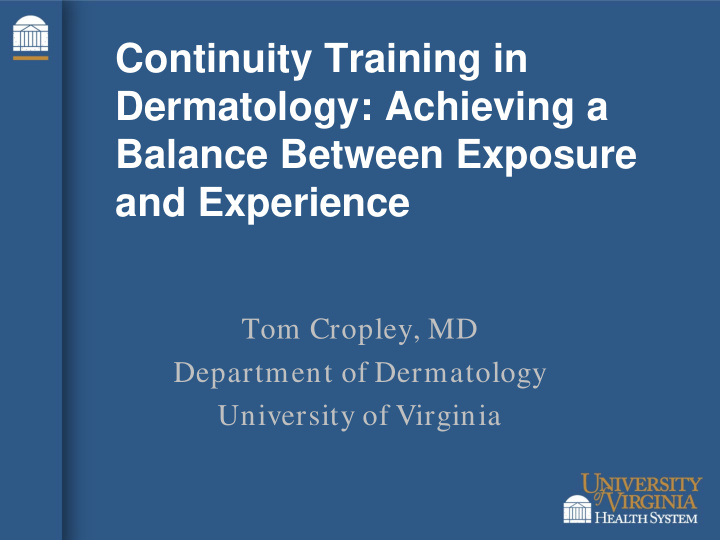



Continuity Training in Dermatology: Achieving a Balance Between Exposure and Experience Tom Cropley, MD Department of Dermatology University of Virginia
I have no relevant industry relationships or other conflicts of interest to disclose
Continuity training: definition • A recurring outpatient clinic experience which gives the resident the opportunity to provide care for a population of patients in a longitudinal fashion. • ACGME wants this to occur at least once weekly for all 3 years, ideally in the same location.
The paradox • Some residency training experiences occur most naturally in a continuity clinic setting: – Learning the natural rhythms of skin diseases (e.g., atopic dermatitis) – Seeing firsthand the results of one’s treatment efforts – Developing relationships with patients and practicing the art of doctoring
The paradox • BUT this requires autonom y for residents as well as supervision , a difficult balance to achieve and maintain • AND continuity clinics have drawbacks – overrepresentation of “bread and butter” cases – financial downside for department – Attendings may be less involved than in their own clinics
Comparing two programs • 9 residents • 6 residents • One primary • One primary practice site practice site • Residents rotate to • Residents rotate weekly peds derm on Mohs and and VA clinics dermpath as 1- month blocks
Comparing two programs • Each resident’s • Each resident’s basic schedule schedule changes template the same from month to for 3 years (i.e., month same attending on • Continuity clinic same half day for 3 attending changes years) monthly
Comparing two programs • Every general • 1-2 continuity derm clinic is a clinics per week continuity clinic • Not all encounters • Every patient seen directly supervised by resident and by attending attending
Comparing two programs • Patient • Patient appointments are appointments are scheduled under scheduled under attending’s name resident’s name • Patients tend to • Patients identify identify attending resident as their as their doctor doctor
Comparing two programs • Resident • Resident vacations, away vacations, away rotations don’t rotations are a mess up schedule headache (attending sees (requires that patients) another resident cover)
Comparing two programs • Resident may not • Residents do have opportunity procedures on to do procedures their own patients on his/ her own patients
Comparing two programs • Residents become • Residents become experienced, experienced, caring, effective caring, effective dermatologists dermatologists • Patients receive • Patients receive top-notch care top-notch care
Advantages • 100% continuity • High degree of (in theory) autonomy • 100% supervision • Opportunities for (in theory) procedures • Diverse case mix • Residents love it • Attendings sleep well at night
Disadvantages • Fewer procedure • More “bread and opportunities butter” case mix than UMass • Residents may feel oversupervised • Attendings worry (less autonomy) that less supervision may lead to quality issues
Conclusions and opinions 1. Both models are effective, and continuity clinics provide unique experiences 2. Both programs have a single primary practice site---multisite programs have other challenges to continuity training 3. A little autonomy goes a long way
Conclusions and opinions 4. The attending’s involvement may at times be a barrier to resident – patient relationship 5. In general, supervision trumps autonomy
Recommend
More recommend